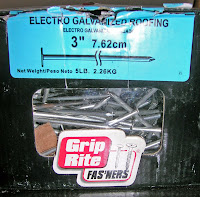
Picking out your nails & staples
The second step in How to Stretch Your own Canvas is the choice of the nails you plan to use for the frame, braces, and stretching the canvas to the frame. Depending on the size of the wood you pick for the frame, the nails will vary. The wider you go the longer the nails need to be. The same goes for the braces. The canvas however, uses completely different nails. Usually I find that a staple gun and staples work best.
1) For the Frame: Frame nails need a larger head which is easier to hit when hammering the wood together. A good size that works well for me is 3 inch Electro Galvanized Roofing nails and they come in various lengths depending on the wood size you are using. Try different nails and sizes and see what works best for your canvas.
1) For the Frame: Frame nails need a larger head which is easier to hit when hammering the wood together. A good size that works well for me is 3 inch Electro Galvanized Roofing nails and they come in various lengths depending on the wood size you are using. Try different nails and sizes and see what works best for your canvas.


2) For the Brace: Brace nails are usually a little smaller with a smaller head as they have a smaller area to go through. The best nail I have found for this is the 3 inch Bright Finish nails. These also come in different lengths depending on your wood. Once more, experiment with different nails and see what works best for you and your canvas.

3) For the Canvas: When attaching the canvas to the frame, depending on the look you want to achieve, there are various nails and staples that work great. You can use a staple gun that uses either industrial staples or nails or small nails. For me, I have found that the use of a staple gun and staples works best and can hold the canvas much tighter than staple gun nails or traditional nails, as well as, easier to work with. The best rule of thumb though is to see what works and feels best for you.

Now that you have your wood and nails chosen, the next step it choosing the canvas you like best. That's coming up next! Until then...Enjoy the Process!
Want to see more about this topic? click here
Like this? Subscribe to Galleria Lisa News







